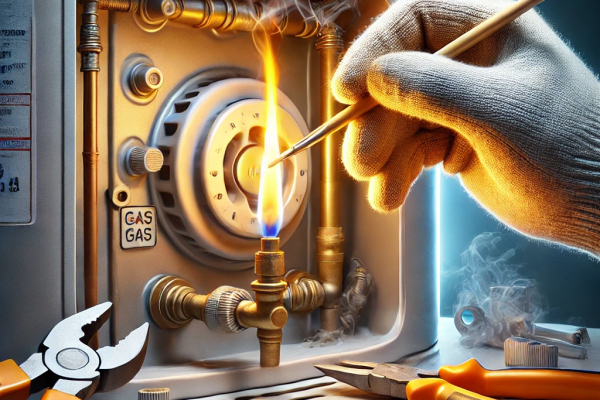
How to Relight a Water Heater's Pilot Light: A Step-by-Step Guide for Texas Homeowners
Introduction: Why It's Important to Maintain Your Water Heater
A water heater is not just an appliance; it is a critical component of your home, providing both comfort and convenience. In Texas, where the climate can push temperatures to extremes, a functional water heater is essential for daily tasks such as showering, washing dishes, and even heating systems for some homes.
However, like all appliances, water heaters can encounter problems. One common issue is a pilot light that goes out. This small but essential component is responsible for igniting the gas that heats your water. Without it, the system will fail to operate, leaving you with cold water when you need it most.
In Texas, where the scorching summer heat can put extra strain on appliances, it’s particularly important to keep an eye on your water heater. Long periods of use or high temperatures can lead to overheating, which may cause the system to malfunction. Luckily, relighting a pilot light is a relatively simple task that many homeowners can do themselves. This article provides a step-by-step guide on how to relight your water heater's pilot light and what to do if the problem persists.
Reasons Your Pilot Light Might Go Out
The pilot light is a small but crucial device that generates the spark necessary to ignite the gas in your water heater. When the pilot light goes out, the gas remains unlit, and the heater fails to heat the water. Understanding the potential causes of this issue is the first step in troubleshooting.
1. Overheating of the Unit
In Texas, especially during the hot summer months, water heaters often experience increased demand. If your heater is working continuously or for extended periods, parts may overheat, causing the pilot light to extinguish. Older models are particularly susceptible to overheating, as they are less efficient at managing heat.
2. Clogged Pilot Light Assembly
Dust, dirt, and debris can accumulate over time in the pilot light assembly, especially if it's located in a hard-to-reach area. These contaminants can obstruct the mechanism, preventing the spark from igniting the gas. Regular cleaning is a simple yet effective solution to this issue.
3. Gas Supply Issues
Another common reason for a pilot light failure is a problem with the gas supply. If the gas flow is weak or if the gas valve is malfunctioning, the pilot light may fail to stay lit. In such cases, it’s best to contact a professional, as the issue may involve working with the gas system.
4. Component Wear and Tear
As with any appliance, parts of your water heater will eventually wear out. If the pilot light assembly or any other component is damaged, it may need to be replaced. If this is the case, a professional repair service may be required.
Preparation Before You Begin
Before attempting to relight your pilot light, it's essential to prepare yourself and ensure safety. Gas appliances require careful handling, and safety should always come first.
Tools You'll Need
- Pliers and Screwdriver: To remove covers and access the pilot light assembly.
- Brush for Cleaning: To remove any dust or dirt around the pilot light area.
- Lighter or Built-In Pilot Light Button: For igniting the pilot light.
- Gloves and Safety Goggles: To protect yourself while handling potentially hot or hazardous elements.
Checking the Water Heater and Safety Precautions
Before you begin, make sure to turn off the water heater. This involves not only powering down the appliance but also cutting off the gas and electricity, if applicable. Turning off the gas supply is crucial to prevent leaks and ensure a safe environment.
Always follow these basic safety measures:
- If you feel uncertain about any part of the process, consult a professional.
- Avoid using the appliance until the pilot light has been successfully relit and the system is functioning properly.
Step-by-Step Guide: How to Relight Your Water Heater’s Pilot Light
Step 1: Turning Off the Water Heater
Start by disconnecting the water heater from all power sources.
- Turn off the gas. Locate the gas valve on your water heater and turn it to the “off” position to stop the gas flow to the pilot light.
- Turn off electricity. If your water heater runs on electricity, turn off the circuit breaker that powers the unit.
- Allow the unit to cool down. If you've recently used hot water, let the unit cool for a few minutes to prevent burns or other injuries.
Step 2: Inspecting the Pilot Light Assembly
Once the unit is turned off and safe to approach, it’s time to inspect the pilot light assembly.
- Remove the access panel. Use a screwdriver to carefully remove the cover protecting the pilot light assembly.
- Clean the pilot light area. Dust and dirt can accumulate in the area around the pilot light, so use a brush or soft cloth to remove any contaminants. Be cautious not to damage any components with harsh chemicals or excessive moisture.
- Check for damage. Look for any visible signs of damage such as cracks or corrosion on the pilot light itself. If the assembly is damaged, it may need to be replaced.
Step 3: Relighting the Pilot Light
Now that you’ve inspected and cleaned the area, you can proceed with relighting the pilot light.
- Turn on the gas. Slowly open the gas valve to allow gas to flow into the pilot light assembly. Be careful not to open the valve too quickly, as this could cause a gas leak.
- Use a lighter or ignition button. If your water heater has a built-in ignition button, press it to ignite the gas. If not, use a long lighter to create a spark and ignite the gas.
- Wait for the flame to stabilize. Once the pilot light is lit, hold the ignition button for a few seconds to ensure the flame stays on. If the flame goes out immediately, this may indicate a problem with the gas flow or the pilot light assembly itself.
Step 4: Checking the Water Heater’s Operation
After successfully relighting the pilot light, it’s important to verify that your water heater is functioning as expected.
- Listen for sounds. When the water heater is working properly, you should hear the sound of water circulating through the system. If you don’t hear anything, this could signal a deeper issue.
- Check the water temperature. Once the pilot light has been lit for several minutes, check the water temperature. It should begin to warm up. If the temperature doesn’t rise, there could be an issue with the heating element or thermostat.
- Check for gas odors. If you smell gas after relighting the pilot light, immediately turn off the gas supply, ventilate the area, and evacuate the premises. Do not attempt to relight the pilot light again until the issue has been resolved.
Conclusion: Preventive Maintenance and Regular Servicing
Relighting the pilot light is often a simple fix, but it’s essential to keep up with regular maintenance to ensure your water heater operates efficiently, particularly in Texas where the climate can put significant strain on your equipment.
Perform a preventive inspection at least once a year to detect potential issues before they lead to bigger problems. This will help keep your water heater in good condition, ensuring it continues to provide reliable hot water throughout the year.
If relighting the pilot light doesn’t solve the issue, or if the light won’t stay on, it may be time to consult a professional plumber. While it’s often a straightforward task, some issues may require expert attention.
Taking these preventive steps will help your water heater run smoothly and efficiently, allowing you to enjoy hot water without the worry of unexpected breakdowns—especially in the heat of a Texas summer.






